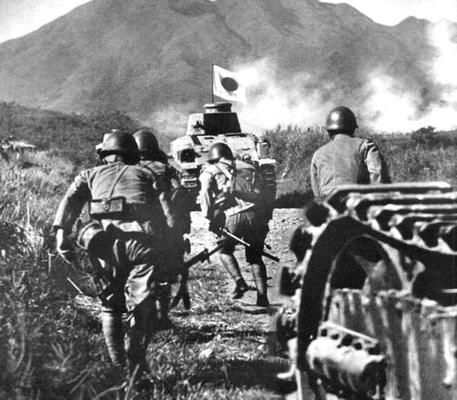During the Second Sino-Japanese War (1937-1945), Japanese soldiers made an attack on Luyi County in Henan Province and tried to blow up a building located at Laojun Terrace on Laojun Mountain. They fired 13 shells, but none of them exploded. The puzzled troops went to examine the site and found that it was a large hall dedicated to Laozi, the founder of Daoism. They were stunned by their discovery, considering it blessings from China’s ancestors that had spared the place from their bombardment, and bowed down to beg for forgiveness.
According to legend, Laozi ascended to Heaven after completing his cultivation in Taoism and reaching immortality. Laojun Mountain was known as a place of retreat for Laozi. During the Han Dynasty (206 B.C. – A.D. 220) Laojun Terrace was built there to revere him and honor his accomplishment. It was destroyed several times during wars and then rebuilt. The ceiling in the main hall was 29 feet high and took up an area of over 2,500 square feet. There were 33 steps to climb, which was believed to be in line with the 33 steps that Laozi had taken to ascend to Heaven.
On the morning of June 1, 1938, Japan’s 4th Division which had been stationed in bordering Anhui Province to the south, pushed northwest into Henan Province and advanced towards Luyi County. The Japanese troops saw two tall buildings and mistakenly thought they were part of the national army’s resistance effort. As a result, the Commander ordered his artillery soldier, a man named Mekawa Taro, to fire at the building on their left which was blasted to pieces. Then he was ordered to target the building on the right but there was no explosion when he fired. He fired again and there was still no sign of destruction.

13 artillery rounds fired at Laojun Terrace fail to explode
After 12 rounds, the Commander became impatient and kicked Mekawa Taro aside. He took over and personally fired the 13th shell, but there was still no explosion. All the soldiers were stunned and wondered why the building could not be blasted. The Japanese then changed their direction and fired dozens of shots aiming at the city. Every shot hit its target and there were explosions. This made the Japanese more curious and uneasy.

The Japanese troops then climbed up to Laojun Terrace to see why the 13 shells failed to explode. On reaching the top, they were stunned to see the statue of Laozi sitting in the main hall. There was an uproar, with some of the men even exclaiming that it was blessings from China’s ancestors that protected the site. All the soldiers knelt down and prostrated themselves in front of the statue to beg for forgiveness and pray for a safe return journey.
Two years later, the Japanese withdrew and the priests returned to Laojun Terrace. When they saw the unexploded shells, they informed the president of the Charity Association, Zhao Wancheng, who sent his brother to investigate. His brother was a private tutor, so he brought along several of his more senior students. They found only 12 of the shells. One had hit the western wall, two penetrated the wall of the main hall, one was stuck in a beam of the main hall, and one landed in front of the altar to Laozi. They collected all the shells and buried them.
At 8 o’clock on the morning of September 5, 2003, while a priest was burning incense in the hall, he heard a loud explosion. When he went to check on what had happened, he found a big hole in the southwest corner of the hall. Some workers had been doing repairs and found a rusty shell underground. This was identified as the 13th shell fired by the Japanese.

In the early 1980s, an elderly man from Japan made a special trip to Laozi’s hometown as part of a tour group. When the group came to Laojun Terrace, they all climbed up to the altar of Laozi to worship.
Artillery man who fired 12 rounds at Laojun Terrace returns many times to repent and worship
The elderly man was Mekawa Taro, the artillery soldier who had fired the 12 rounds of shells. Mekawa made frequent trips to Luyi County throughout his life, and his purpose was always the same — to worship and repent.
On September 19, 1997, during Mekawa’s last trip, he and his comrades-in-arm brought along a Japanese-style monument and placed it in front of the altar of Laozi. They knelt down to repent and to pray for world peace.
Translated by Chua BC and edited by Mikel Davis







